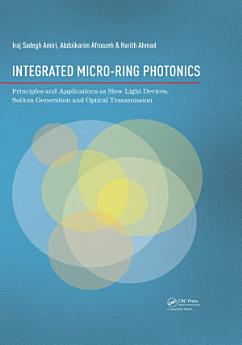Integrated Micro-Ring Photonics: Principles and Applications as Slow Light Devices, Soliton Generation and Optical Transmission
About this ebook
About the author
Dr. I.S. Amiri received his B. Sc (Hons, Applied Physics) from Public University of Oroumiyeh, Iran in 2001 and a gold medalist M. Sc. from Universiti Teknologi Malaysia (UTM), in 2009. He was awarded a PhD degree in nanophotonics in 2014. He has published more than 260 journals/conferences and books in Optical Soliton Communications, Nano photonics, Nonlinear Fiber Optics, Quantum Cryptography, Optical Tweezers, Nanotechnology, Biomedical Physics and Biotechnology Engineering.
Dr. Abdolkarim Afroozeh completed his MSc in the field of Astronomy at Shiraz University, Iran, in 2001. He was awarded a PhD degree in photonics from Universiti Teknologi Malaysia (UTM) in 2014. He has published more than 70 journals/conferences papers and books/chapters in Optical Soliton Communications, Laser Physics, photonics, Nonlinear fiber optics, Quantum Cryptography, Nanotechnology, Biomedical Physics and Biotechnology Engineering. Now, He is working in Young Researchers and Elite Club, Jahrom Branch, Islamic Azad University, Jahrom, Iran and The Department General of Fars Province Education, Iran.
Dr. Harith Ahmad received the PhD degree in laser technology from the University of Wales, Swansea, UK, 1983. He is a Professor with the Department of Physics, University of Malaya where he has actively pursued research activities in the field of photonics since 1983. Currently he is also the Director of Photonics Research Centre, University of Malaya. He is the author of more than 850 papers in international journals. His research interest is in lasers, fiber-based devices for telecommunications, and fiber-based sensor devices. Dr. Ahmad is a Fellow of the Academy of Sciences, Malaysia.




